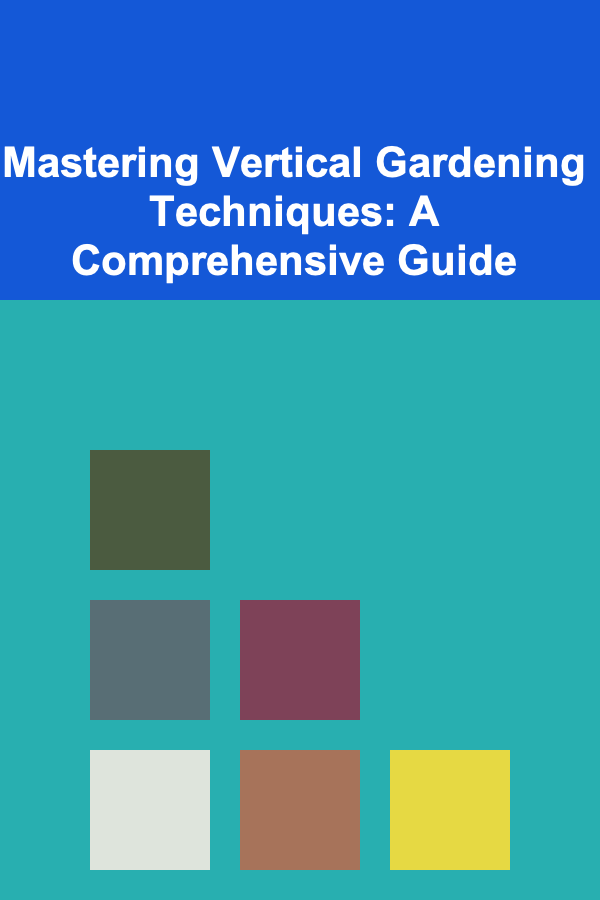
Mastering Vertical Gardening Techniques: A Comprehensive Guide
ebook include PDF & Audio bundle (Micro Guide)
$12.99$9.99
Limited Time Offer! Order within the next:

Vertical gardening, the art of growing plants upwards rather than outwards, is transforming urban landscapes and home gardens alike. This innovative approach maximizes space, enhances aesthetics, and offers a unique way to cultivate fresh produce and vibrant greenery. Whether you're a seasoned gardener or a curious beginner, this comprehensive guide will equip you with the knowledge and skills to master vertical gardening techniques.
The Allure of Vertical Gardening
Before diving into the technical aspects, let's explore the compelling reasons why vertical gardening has become so popular:
- Space Efficiency: Ideal for small spaces like balconies, patios, and urban apartments, vertical gardens make the most of limited square footage.
- Aesthetic Appeal: Living walls and vertical planters add a touch of natural beauty to otherwise sterile environments, creating a calming and inviting atmosphere.
- Improved Air Quality: Plants naturally filter air pollutants, contributing to a healthier indoor and outdoor environment.
- Accessibility: Vertical gardens often make gardening more accessible to individuals with mobility issues, reducing the need to bend or kneel.
- Increased Yield (Potentially): Properly designed vertical systems can optimize sunlight exposure and airflow, potentially leading to higher yields for certain crops.
- Pest and Weed Control: Elevated gardens are often less susceptible to ground-dwelling pests and weeds, simplifying maintenance.
- Insulation: Living walls can provide a layer of insulation, helping to regulate temperature and reduce energy costs.
Types of Vertical Gardening Systems
The vertical gardening world offers a diverse range of systems, each with its own advantages and suitability for different applications. Understanding these options is crucial for selecting the best fit for your needs.
1. Living Walls (Green Walls)
Living walls are self-sufficient ecosystems attached to a vertical surface. They typically involve a modular system with pockets or panels filled with a growing medium and plants. These systems often incorporate irrigation and drainage mechanisms.
Key Features:
- Complex Systems: Often require professional installation and maintenance, especially for large-scale applications.
- Automated Irrigation: Typically feature automated irrigation systems to ensure consistent watering.
- Wide Plant Variety: Can support a wide variety of plants, from groundcovers to small shrubs.
- High Aesthetic Impact: Creates a stunning visual impact, transforming walls into living works of art.
Considerations: Cost, maintenance requirements, weight considerations for the wall structure.
2. Pallet Gardens
Pallet gardens repurpose wooden pallets into vertical planters. This is a DIY-friendly and cost-effective option.
Key Features:
- DIY Project: Easy to create with basic woodworking skills and readily available materials.
- Recycled Materials: Promotes sustainability by repurposing discarded pallets.
- Affordable: A budget-friendly option for vertical gardening.
- Rustic Charm: Adds a rustic and charming aesthetic to any space.
Considerations: Ensuring the pallet is untreated and safe for growing food, proper lining to prevent soil erosion, weight limitations.
3. Hanging Baskets
Hanging baskets are a classic vertical gardening technique. They are versatile and easy to install.
Key Features:
- Versatile: Can be hung from balconies, patios, fences, or trees.
- Easy to Install: Simple to set up and maintain.
- Wide Plant Selection: Suitable for a wide variety of trailing and cascading plants.
- Portable: Easy to move around to optimize sunlight exposure.
Considerations: Weight limitations of the hanging structure, watering frequency, potential for dripping.
4. Stacked Planters
Stacked planters are modular systems that allow you to stack multiple pots or containers on top of each other, creating a vertical tower of plants.
Key Features:
- Easy Assembly: Simple to assemble and disassemble.
- Modular Design: Allows for customization and expansion.
- Space-Saving: Maximizes vertical space without requiring wall mounting.
- Good Drainage: Often designed with drainage holes to prevent overwatering.
Considerations: Stability, watering the top layers may require more frequent attention, weight distribution.
5. Trellises and Arbors
Trellises and arbors provide vertical support for climbing plants like vines and flowering climbers.
Key Features:
- Natural Support: Provides a natural and aesthetically pleasing support structure for climbing plants.
- Adds Height and Dimension: Creates a sense of height and dimension in the garden.
- Variety of Materials: Available in a variety of materials, including wood, metal, and plastic.
- Versatile Design: Can be used to create arches, tunnels, and other decorative features.
Considerations: Choosing the right trellis size and material for the specific plant, ensuring the trellis is securely anchored.
6. Pocket Gardens
Pocket gardens involve using fabric or plastic pockets attached to a vertical surface to hold plants. These are often made of felt or recycled materials.
Key Features:
- Lightweight: Generally lightweight and easy to install.
- Affordable: Can be a cost-effective option, especially when DIY-ed.
- Good Drainage: Often incorporates drainage mechanisms to prevent waterlogging.
- Versatile: Suitable for a wide range of small plants, herbs, and succulents.
Considerations: Durability of the material, potential for drying out quickly, choosing plants that are well-suited to the pocket size.
7. Gutter Gardens
Gutter gardens repurpose rain gutters into vertical planters. This is a creative and space-saving solution.
Key Features:
- Repurposed Materials: Utilizes recycled rain gutters, promoting sustainability.
- Space-Saving: Ideal for narrow spaces and balconies.
- Easy to Install: Relatively easy to install with basic plumbing knowledge.
- Good Drainage: Naturally provides good drainage.
Considerations: Ensuring proper drainage, selecting lightweight potting mix, weight limitations of the support structure.
Essential Considerations for Vertical Gardening
Successfully establishing and maintaining a vertical garden requires careful consideration of several key factors:
1. Location and Sunlight
Understanding the sunlight requirements of your chosen plants is paramount. Most plants need at least six hours of direct sunlight per day. However, some plants thrive in partial shade. Consider the following:
- Orientation: South-facing walls receive the most sunlight, while north-facing walls receive the least. East- and west-facing walls offer intermediate sun exposure.
- Sunlight Duration: Track the amount of sunlight your chosen location receives throughout the day and year.
- Adjustments: If sunlight is limited, consider using grow lights to supplement natural light. Reflective surfaces can also help to maximize sunlight exposure.
2. Soil and Growing Medium
The soil or growing medium used in vertical gardens must be lightweight, well-draining, and nutrient-rich. Standard garden soil is often too heavy and compacts easily. Consider these options:
- Potting Mix: A good quality potting mix is a suitable option for most vertical gardens.
- Soilless Mix: Soilless mixes, such as those containing peat moss, perlite, and vermiculite, are lightweight and provide excellent drainage.
- Coco Coir: Coco coir is a sustainable alternative to peat moss. It retains moisture well and provides good aeration.
- Custom Blend: You can create your own custom blend by combining potting mix, compost, and perlite or vermiculite.
3. Watering and Irrigation
Proper watering is crucial for the health of your vertical garden. Vertical gardens tend to dry out more quickly than traditional gardens due to increased exposure to air and sunlight. Consider these watering techniques:
- Manual Watering: Use a watering can or hose to water your plants regularly. Check the soil moisture levels before watering.
- Drip Irrigation: Drip irrigation systems deliver water directly to the roots of plants, minimizing water waste and promoting healthy growth.
- Self-Watering Systems: Self-watering systems use reservoirs to provide a consistent supply of water to plants. These systems are ideal for busy gardeners.
- Watering Frequency: Watering frequency will depend on the type of plants, the climate, and the growing medium. Generally, you should water when the top inch of soil feels dry to the touch.
Tip: Consider using a moisture meter to accurately assess soil moisture levels. This will help you avoid overwatering or underwatering your plants.
4. Fertilization
Vertical gardens often require regular fertilization to provide plants with the nutrients they need to thrive. Nutrients can leach out of the soil more quickly in vertical systems. Consider these fertilization methods:
- Slow-Release Fertilizer: Incorporate slow-release fertilizer granules into the growing medium at planting time. These granules release nutrients gradually over time.
- Liquid Fertilizer: Apply liquid fertilizer regularly during the growing season. Follow the instructions on the fertilizer label.
- Compost Tea: Compost tea is a nutrient-rich liquid that can be used to fertilize plants. It is a natural and sustainable option.
5. Plant Selection
Choosing the right plants is essential for a successful vertical garden. Consider the following factors:
- Sunlight Requirements: Select plants that are well-suited to the amount of sunlight your vertical garden receives.
- Growth Habit: Consider the growth habit of the plants. Trailing and cascading plants are ideal for hanging baskets and stacked planters. Climbing plants are well-suited for trellises and arbors.
- Size: Choose plants that are appropriately sized for the containers or pockets you are using.
- Maintenance Requirements: Select plants that are relatively easy to care for.
- Compatibility: Ensure that the plants you choose are compatible with each other in terms of sunlight, water, and nutrient requirements.
6. Pest and Disease Control
Vertical gardens can be susceptible to pests and diseases. Implement preventative measures to minimize problems:
- Inspect Plants Regularly: Regularly inspect your plants for signs of pests or diseases.
- Use Organic Pest Control Methods: Consider using organic pest control methods, such as neem oil or insecticidal soap.
- Provide Good Air Circulation: Good air circulation can help to prevent fungal diseases.
- Remove Infected Plants: Remove any infected plants promptly to prevent the spread of disease.
Warning: Avoid using chemical pesticides and herbicides in vertical gardens, especially if you are growing edible plants.
7. Structural Integrity and Weight
Consider the weight of your vertical garden system, especially when installing it on walls or balconies. Ensure the support structure is strong enough to bear the weight of the system when it is fully saturated with water. Over time, the added weight of mature plants can also impact structural integrity.
- Wall Mounting: For wall-mounted systems, use appropriate anchors and fasteners to ensure the system is securely attached to the wall. Consult with a structural engineer if necessary.
- Balcony Weight Limits: Be aware of the weight limits of your balcony. Avoid overloading the balcony with heavy vertical garden systems.
- Regular Inspection: Regularly inspect the support structure for signs of wear and tear.
Plant Recommendations for Vertical Gardens
The best plants for your vertical garden will depend on your climate, sunlight exposure, and personal preferences. Here are some popular and versatile options:
Flowers
- Petunias: Trailing petunias are ideal for hanging baskets and stacked planters.
- Impatiens: Impatiens thrive in shady locations and are perfect for adding color to vertical gardens.
- Begonias: Begonias are available in a wide range of colors and shapes and are well-suited for vertical gardens.
- Geraniums: Geraniums are drought-tolerant and easy to care for, making them a good choice for beginners.
- Nasturtiums: Nasturtiums are edible flowers that add a peppery flavor to salads. They also attract beneficial insects.
Herbs
- Mint: Mint is a fast-growing herb that is ideal for hanging baskets. Be aware that it can be invasive, so it's best to contain it.
- Basil: Basil is a popular herb that is easy to grow in vertical gardens.
- Thyme: Thyme is a drought-tolerant herb that thrives in sunny locations.
- Rosemary: Rosemary is a fragrant herb that is well-suited for vertical gardens.
- Oregano: Oregano is a hardy herb that is easy to grow in vertical gardens.
Vegetables
- Lettuce: Lettuce is a cool-season crop that can be easily grown in vertical gardens.
- Spinach: Spinach is another cool-season crop that thrives in vertical gardens.
- Strawberries: Strawberries are a popular fruit that can be grown in hanging baskets and stacked planters.
- Tomatoes (Dwarf Varieties): Dwarf tomato varieties are well-suited for vertical gardens.
- Peppers (Small Varieties): Small pepper varieties, such as chili peppers, can be grown in vertical gardens.
Succulents
- Sedum: Sedum are drought-tolerant succulents that are ideal for vertical gardens.
- Echeveria: Echeveria are rosette-shaped succulents that are available in a wide range of colors.
- Sempervivum: Sempervivum are hardy succulents that can tolerate cold temperatures.
- Crassula: Crassula are a diverse group of succulents that includes the popular jade plant.
- Senecio: Senecio includes trailing varieties like String of Pearls, perfect for cascading down vertical walls.
Other Plants
- Ferns: Certain fern varieties, like Maidenhair Fern, thrive in shady, humid vertical gardens.
- Air Plants (Tillandsia): Air plants require no soil and can be attached to vertical surfaces with adhesive or wire.
- Moss: Moss can be used to create a lush, green backdrop in vertical gardens.
DIY Vertical Garden Projects
Ready to get your hands dirty? Here are a few DIY vertical garden project ideas to get you started:
1. Pallet Garden
- Prepare the Pallet: Choose an untreated pallet. Sand down any rough edges and staple landscape fabric to the back and sides of each section to create pockets.
- Add Soil: Fill the pockets with a lightweight potting mix.
- Plant: Plant your chosen herbs, flowers, or vegetables in the pockets.
- Water: Water thoroughly after planting.
- Hang or Lean: Hang the pallet garden on a wall or lean it against a fence.
2. Gutter Garden
- Prepare the Gutters: Cut rain gutters to the desired length. Drill drainage holes along the bottom of each gutter.
- Install End Caps: Attach end caps to each end of the gutters.
- Mount the Gutters: Mount the gutters to a wall or fence using brackets.
- Add Soil: Fill the gutters with a lightweight potting mix.
- Plant: Plant your chosen herbs, flowers, or vegetables in the gutters.
- Water: Water thoroughly after planting.
3. Hanging Shoe Organizer Garden
- Prepare the Organizer: Purchase a fabric shoe organizer with multiple pockets.
- Reinforce the Pockets (Optional): Reinforce the pockets by stapling landscape fabric to the back of each pocket.
- Hang the Organizer: Hang the shoe organizer on a wall or fence.
- Add Soil: Fill the pockets with a lightweight potting mix.
- Plant: Plant your chosen herbs, flowers, or succulents in the pockets.
- Water: Water thoroughly after planting.
Troubleshooting Common Vertical Gardening Problems
Even with careful planning, you may encounter some challenges when growing a vertical garden. Here's how to address some common problems:
- Plants are drying out quickly: Increase watering frequency, use a more water-retentive growing medium, or add a layer of mulch to the soil surface.
- Plants are turning yellow: This could be a sign of overwatering, underwatering, or nutrient deficiency. Check the soil moisture levels and fertilize if necessary.
- Plants are not growing: Ensure the plants are receiving adequate sunlight, water, and nutrients. Check the soil pH and adjust if necessary.
- Pests are attacking the plants: Use organic pest control methods to eliminate pests. Remove any heavily infested plants.
- The vertical garden is sagging: Ensure the support structure is strong enough to bear the weight of the garden. Reinforce the structure if necessary.
The Future of Vertical Gardening
Vertical gardening is more than just a trend; it's a sustainable solution for urban food production and greening our cities. As technology advances, we can expect to see even more innovative vertical gardening systems, including:
- Smart Vertical Gardens: Equipped with sensors and automated systems for irrigation, fertilization, and climate control.
- Vertical Farms: Large-scale indoor farms that utilize vertical growing techniques to produce food year-round.
- Integration with Green Buildings: Incorporating living walls into building designs to improve energy efficiency and air quality.
By embracing vertical gardening techniques, we can create more sustainable and beautiful living spaces for ourselves and future generations.
Conclusion
Mastering vertical gardening techniques opens a world of possibilities for cultivating vibrant greenery and fresh produce in even the smallest of spaces. By understanding the different types of systems, considering essential factors like location, soil, and watering, and choosing the right plants, you can create a thriving vertical garden that enhances your environment and nourishes your soul. So, take the plunge, experiment, and enjoy the rewarding experience of growing upwards!

How to Maintain Your Home's Lawn Sprinkler System
Read More
How to Make Money Online as a Travel Agent: 10 Actionable Ideas
Read More
How to Use Online Course Creation Tools to Make Money
Read More
Finding Reliable Local Guides: A Comprehensive Guide
Read More
How to Control Sodium Intake in Your Diet
Read More
How to Produce Glitch Hop with FL Studio
Read MoreOther Products

How to Maintain Your Home's Lawn Sprinkler System
Read More
How to Make Money Online as a Travel Agent: 10 Actionable Ideas
Read More
How to Use Online Course Creation Tools to Make Money
Read More
Finding Reliable Local Guides: A Comprehensive Guide
Read More
How to Control Sodium Intake in Your Diet
Read More